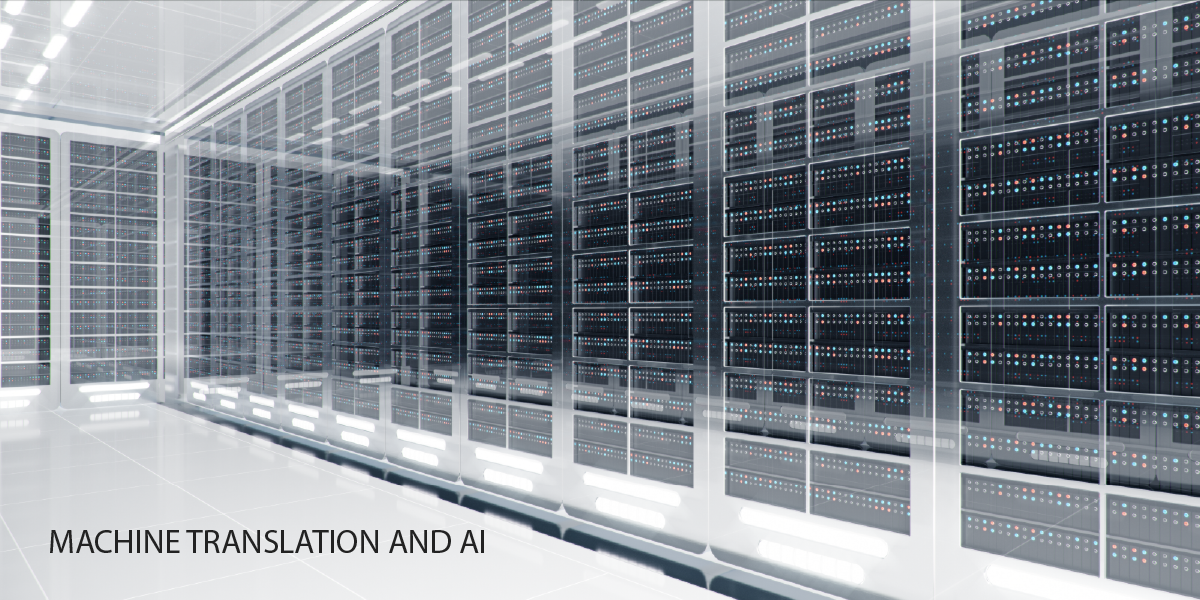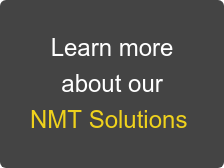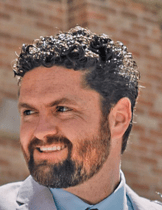
Word on the Street
TIPS TO BEGIN WORKING WITH MACHINE TRANSLATION Original Article by Adam Wooten in Multilingual Magazine - Issue Oct 2018 |
|
|||
|
About the Author Adam Wooten Adam Wooten, localization consultant and trainer at be.international, has more than 15 years of experience in the language industry. He is assistant professor in the translation and localization management program at the Middlebury Institute of International Studies, and the former CEO and cofounder of AccuLing.
|
||||
No one can deny that machine translation (MT) services are becoming increasingly mainstream. Customizable MT is no longer limited to translation departments at major technology developers like Google and Microsoft, largely because these same tech companies and others like SDL and KantanMT are making customizable MT easily available to everyone.
Earlier this year, Ben Sargent of Common Sense Advisory (CSA Research) wrote that one-third of small language service providers (LSPs) with annual revenues under $500,000 claim to be using MT. The think tank’s same survey showed MT use is even more common among larger companies, including 90% of LSPs with annual revenues over $20 million.
As more LSPs and client-side companies decide to begin using MT and progressing along the Machine Translation Maturity Model, what can make the leap a little easier for newcomers? The executive team at TLG (The Language Group, LLC) was kind enough to share some tips. TLG has offered traditional translation and interpretation services for decades, but a portion of the revenue growth that put the company on the 2018 Inc. 500 list can be attributed to its MT services. At TLG, I interviewed Giovanni Donatelli, CEO and founder; Thomas Edwards, senior vice president and general manager; Mary Wilson, director of client services and Rolf Hecken, director of production consultant.
Projects appropriate for MT
Wooten: What is an example of a recent MT project that TLG has completed? And why was MT a good fit for that project?
Edwards: We recently performed a seven million-word and 35,000-page project for a large defense contractor that provides dogfight training to the US Navy. The project consisted of localizing — from French into English — large amounts of technical user and maintenance manuals for a large fleet of supersonic fighter planes. Cost and timing were an issue as the content was needed quickly to get FAA certification before the planes could fly. This project would have cost $3 million and taken over 12 months using traditional translation, but post-edited machine translation was a better solution as it enabled TLG to complete the work for 20% of the traditional cost within five and a half months from start to finish. Wooten: Has your increase in machine translation services affected your traditional translation offerings in any way?
Edwards: There is a natural fear that MT or post-edited MT will cannibalize the other services offered by the LSP. Will the client only ask for MT from now on? The main concern is that if an LSP provides a lower-cost solution like post-edited MT, the traditional translation clients will only want that moving forward.
MT must be used for the right content and the client must be educated to know the difference. Marketing communication and glossy advertising pieces are not appropriate for MT. Technical documentation, user manuals and website content can often be appropriate content for MT.
Differences from traditional projects
Wooten: For those who are new to MT projects, what would you say are some of the similarities they share with traditional translation projects? And what are some of the key differences?
Hecken: Ultimately, you are dealing with a paying customer who expects the highest return on their investment. So, as always, assembling the best team and right toolbox of utilities will help you accomplish the job, which is both crucial and fundamental in MT as in any other translation project. What is different is that upfront project preparation is even more important than for a traditional translation project. Most of the time an MT or post-edited MT project is much larger in scope than a traditional translation project, usually millions of words as opposed to thousands of words.
Like traditional translation, MT projects require team building, learning, review and properly allotted training time. Like any new employee, a proper MT engine needs training, review and learning to fit the project scope, the content, the terminology and the client’s needs and requirements. You will not be able to hit the ground running just by adding an untrained MT engine. Allowing yourself training time at the start is half the battle. MT projects — with or without post-editing — are also continuously evolving processes. Newly generated content is fed back into the MT engine and used to retrain it and create more accurate output. Like any employee or translator who would be exposed to continuous learning and professional skills development, your MT engine will become a more and more valuable team member as the project unfolds.
Wooten: With all the training required before and after project kickoff, it seems there would be many more unknowns at the start of an MT project than in a traditional translation project. What are some of those unknowns that might cause fear for newcomers to machine translation?
Hecken: It is important to have an understanding that production costs may be uncertain when first estimated, as discoveries can be made when the project is underway. This is especially true when an LSP is trying to pass cost savings along to a client. Wilson: It is also okay to not know the quality of the raw MT output when you begin the project. The only way to know how MT will work for specific content is to use it and then train the system to reach the best output possible.
Wooten: Cost and quality are usually simpler to estimate on traditional translation projects. How can an LSP minimize such uncertainty at the start of an MT project?
Hecken: A pilot project will give the client and the LSP a firm under-standing of what the project will entail once it is scaled to full capacity. Donatelli: Yes, we help guide the discussion to eliminate the fear of the unknown by showing the client what the output would look like. This allows the client to see if they can achieve their goals using our
solution. If they feel that the output is not polished enough, we can make some improvements like adding a level of post-editing and then show them the next level of quality. This allows the client to discern among different quality levels. We have seen that this approach tends to eliminate the fear of the unknown as clients see tangible results and how they are achieved. Once the client is satisfied with the quality of the product, we then lock in the process and start production. But it all starts with showing the client tangible proof of the solution up front.
Building the MT project team
MT solutions architect
Wooten: Although team makeup will vary from project to project, what are some of the key roles that must be filled on a typical MT project team? What are some of the key skills and attributes needed for each role?
Hecken: A solutions architect outlines the process and steps that will be required in the project workflow.
Donatelli: Yes, solutions architects are familiar with a majority of the tools in the marketplace such as MT, translation memory (TM), project management, optical character recognition and desktop publishing tools and how they work interconnectedly. They are creative problem solvers, personable and able to communicate their ideas clearly, often in a position to teach other staff how to use certain tools.
MT account manager
Edwards: An account manager on the LSP side is crucial to setting proper expectations. They should not sugarcoat the risks of MT. It will not be as good as traditional human translation. It will help tremendously with timet o market and cost. The account manager must work with the client in understanding risk tolerance and the reality that you do get what you pay for.
Donatelli: As a project continues, account managers must be ready to speak with clients on a regular basis. They must demonstrate an even personality as they will be dealing with deadlines, problems that may arise and how to communicate these changes to the client.
MT project manager
Hecken: A project manager must have either a strong technical ability or the ability to delegate some of the technical set up and tasks to the appropriate team members.
Donatelli: And, as usual, project managers must be comfortable in a busy environment where direction of a project may change on a regular basis. In this environment, they must be highly organized and have excellent attention to detail.
Vendor manager
Hecken: A vendor manager is crucial to selecting the linguistic team that is experienced in MT projects or the vendor manager must be able to perform or coordinate specialized training.
Donatelli: A former linguist is often a good candidate for this type of position.
Post-editors
Hecken: Post-editors need to be fast, flexible and ready to take on the projects. Everything is very time-sensitive. The volumes are high and traditional linguists sometimes tend to want to make everything perfect — as if it were a 100% human translation project. However, the reality is that a post-edited MT project is different. The linguists need to be aware of the quality output the project manager and client are expecting.
Wilson: Build a post-editing team that is comfortable with using the tools and that will adhere to the level of editing necessary to reach the desired outcome. To ensure the post-editors are successful, implement a solid plan and platform for the entire team to be able to communicate and access resources. The resources they will need include a solid working environment (computer assisted translation tool), any linguistic resources (TM and glossary) and a clear style guide that outlines the desired outcome.
Final thoughts
Wooten: Do you have any final thoughts or tips for those looking to get started with MT? 
Wilson: Communication is crucial as MT projects progress. Address challenges as they occur and provide solutions and options for the client. Keep the overall goal of the project and desired outcome in mind when faced with hurdles. Hecken: In these projects, we are typically dealing with massive amounts of data that is needed for very specific purposes, so understanding your client’s needs and purposes will allow you and your client to achieve the necessary results. The advances made in neural MT and other technologies, paired with an overload of world-wide information that needs to be filtered and made available for proper decision making has created unique new types of projects that need servicing. These are exciting times, not scary ones. [M]

